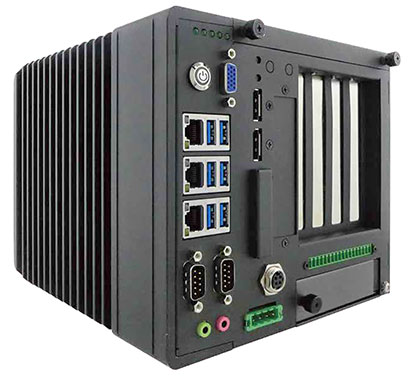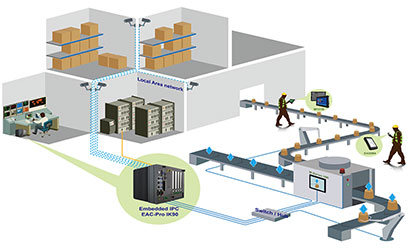|
Winmate EAC-PRO
Intel 6th generation-based embedded computer for factory floor, vision systems, surveillance, machine automation, medical imaging and similar
(by Conrad H. Blickenstorfer)
Most computers we use in our daily lifes fall into well-defined categories. Desktops, laptops, smartphones, tablets, everyone knows what they are, what they're used for, and what they look like. There are, however, countless millions of computers that do their work behind the scenes. They're collectively called "embedded systems" and they come in numerous shapes and forms. Some are just boards, some come in enclosures, and none fall into easily recognizable categories.
Winmate's new EAC-PRO is one of those. It's cube-shaped and the company simply calls it "Embedded Computer." Unlike most embedded systems, the EAC-PRO is actually part of a class or type insofar as several other Taiwanese manufacturers also make such industrial cubes, calling them "embedded automation controller," "fanless embedded computer," or "rugged expandable controller." So what, exactly, are these cube computer things?

There really is no good answer. Just like "embedded" systems come as boards or clad in all sorts of enclosures, these cubes come as cubes probably because a cube is a pretty efficient shape to stuff full of COTS (commercial off the shelf) components. Unlike rack-mounts or towers, a cube-shaped computer can go pretty much anywhere. Most such industrial cubes measure roughly 8 x 8 x 8 inches and weigh 10-12 pounds or so, and the EAC-PRO is no exception.
The illustration below shows what a cube like the Winmate EAC-PRO might be used for. In the example, it's used in a factory to run a number of surveillance cameras, display multiple video streams on high-res independent displays (it can run up to three), and also interact with factory floor and assembly line systems.

That, of course, is just one example. Cubes are in essence just general-purpose PCs equipped with plenty of I/O. So depending on a cube's configuration, it can be used in all sorts of ways in areas such as factory floor HMI applications, vision systems, surveillance, signage, machine automation, medical imaging and many more.
Note that while many embedded systems are designed and configured for very specific applications and come with just as much performance and I/O as is needed for the job, cubes are inherently multi-purpose and more flexible, providing plenty of performance and a whole gamut of I/O, and that applies to the Winmate EAC-PRO.
So let's see what's under the hood of the Winmate EAC-PRO. That would be your choice of one of three available embedded Intel processors. All are of the 6th generation "Skylake" variety, i.e. recent, powerful, and very efficient 14nm designs. Winmate offers the dual-core, non-turbo i3-6100TE; the quad-core, octa-thread i7-6700TE, and then the Xeon E3-1268L v5 which also has four cores and eight threads. For a comparison of the three processors' specs, see this table.
What are the general differences between these chips? Not as much as one would expect. All have integrated Intel HD Graphics P530, with the Core chips following Intel's i3/i5/i7 = good/better/best approach. Back in the day, Xeon chips were to Core chips like Diesels are to gasoline combustion engines, with the Xeons excelling at handling sustained, heavy load. These days, the specs of the i7 and the Xeon look much the same, with the exception that the Xeon can use error-correcting ECC RAM and and i7 can't.
Note that even though all available processors are good performers, thermal design power for all is just 35 watts. That's essentially laptop-class; desktop chips routinely have TDPs in the 65 to 95 watt range. The reason is that none of the four available processors needs a CPU fan, which is a big plus in embedded systems. Fans mean dust, fans need to be cleaned, fans are noisy and fans often break down, which isn't what you want in industrial systems that must reliably run 24/7/365 and are often installed in locations that are not easy to get to.
On the memory side, the EAC-PRO can accommodate up to 32GB of DDR4 RAM in two slots. Storage is essentially unlimited via two swappable and two on-board SATA 3 drives and RAID 0/1/5/10 support. If that's not enough, there's also SATA 2 CFast.
As expected, the EAC-PRO excels in connectivity. Externally accessible are six USB 3.0 ports, three gigabit RJ45 LAN jacks, 8-channel digital IO, and dual switchable serial ports. For video, there's VGA and two DisplayPort jacks, all three of which can be active simultaneously. Inside there are additional pin headers for four more COM ports, a legacy LPT port, PS/2, and also a couple of miniPCIe sockets for expansion. A total of four PCI expansion slots comes in two different SKUs.
So why go for a "cube" form factor PC than for a rackmount or box PC? Primarily because the cube is perfect for projects that do require PCI and PCI Express expansion in a compact, industrial-grade package. And with Winmate using an embedded systems approach with the EAC-PRO, the company should easily be able to accommodate custom configurations with different SBC (Single Board Computer) and I/O boards.
|





